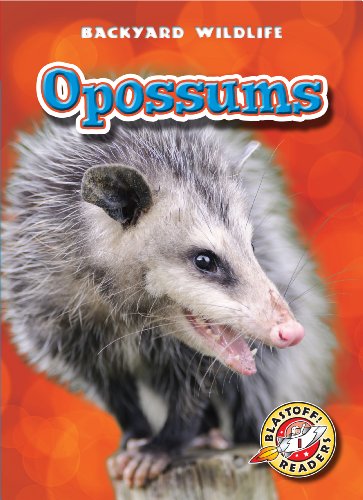-
Humpback Whale Migration
Kari Schuetz
Library Binding (Bellwether Media, Aug. 1, 2018)Humpback whales can hold their breath up to 45 minutes as they torpedo through ocean waters! These mighty mammals migrate from their summer arctic waters to the warm, winter waves near the equator to give birth to their calves. Young readers will want to dive into this title and follow the travels of humpback whales. Infographics give quick stats on the animal and their journeys. Migration maps show the travel path and main stopping points. Warning signs use iconography to call out travel dangers and obstacles. Speedometer graphics highlight top speed. L
L
-
Opossums
Emily K. Green
Library Binding (Bellwether Media, Jan. 1, 2011)When a predator is near, an opossum will likely do one of two things. It will try to scare the predator away by showing its sharp teeth, or it will lie very still and pretend it's dead! In this book, beginning readers will discover how these marsupials escape predators and carry their young babies in pouches. K
K
-
Gorillas
Derek Zobel
Library Binding (Bellwether Media, Aug. 1, 2011)The way a gorilla moves is called knuckle-walking. This is because the animal puts pressure on its knuckles when it moves. Beginning readers will learn how gorillas walk, why they beat their chests, and more in this informative title. J
J
-
Monster Trucks
Kay Manolis
Library Binding (Bellwether Media, Feb. 1, 2008)A monster truck rolls over a car and crunches it under its huge wheels. Monster trucks are giant pickup trucks that can race around a track. Kids will roar with excitement as monster trucks dominate this book's pages. I
I
-
Snakes
Emily Green
Library Binding (Bellwether Media, Aug. 8, 2010)Snakes come in a variety of shapes and sizes. Some are only a few feet long, while others can stretch over 40 feet long! This title introduces young readers to the traits of snakes, what and how they eat, and where they make their homes. P
P
-
Anacondas
Rachel Grack
Library Binding (Bellwether Media, Jan. 1, 2019)An anaconda slides into the murky river. Then, it pokes its nostrils above the water to wait for its next meal! This book for young readers details the body parts and survival skills that anacondas have adapted to survive their rain forest habitat. K
K
-
Armadillos
Kari Schuetz
Library Binding (Bellwether Media, Aug. 1, 2011)A shell of bony plates covers an armadillo's body. This dense body armor protects the animal, but it also makes swimming difficult. To avoid sinking in water, an armadillo must inflate its stomach with air! In this book, children will learn about the diet, habitat, and unique look of the armadillo. H
H




